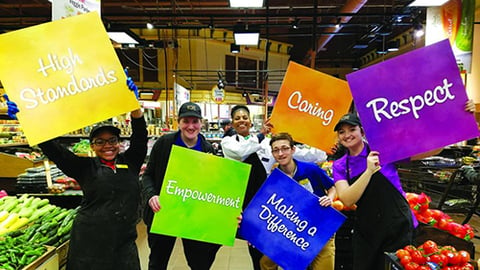3 Employee-Engaging Strategies to Enhance the Customer Experience
Whether a superstore or grocer, the backbone of any retailer is the employees who are on the store floor.
How your employees feel (and therefore act) within the workplace impacts how customers shop, how often they return and how much they spend.
In fact, a 5% increase in employee engagement has shown to result in a 3% boost in revenue, according to human capital and management consulting services Aon Hewitt. On top of that, companies with happy employees experience 81% higher customer satisfaction.
It’s no secret anymore:
Employee and customer satisfaction are intrinsically linked.
This link strengthens the need to encourage your customers to visit in-store as opposed to opting for home delivery. It also strengthens the need to engage your employees properly.
Here, we’ll outline the top 3 ways to engage grocery store employees for the best results this year.
For years, it was considered “good enough” to provide staff with a place to do their best work. However, as more research shows the benefits of staff engagement, companies are realizing the workplace needs to provide more than just the basics.
1. Lead Your Employees as Individuals
According to IES research, one of the key drivers for high employee engagement is consistent high-quality interactions with managers.
The way you interact with your employees and how you structure your team and strategy shape engagement throughout your store. To achieve these high-quality interactions, create conversations that support employees as individuals with unique traits, and less as workers who need direction.
While this may be difficult for some managers, all you need to do is try out a few of these conversation-starters:
- Think of yourself as a coach rather than a manager.
- Ask your employees what their motivations are (inside and outside of work and how they relate).
- Listen to your employees’ perspectives, ask them their opinion on how to improve in-house management or customer engagement.
- Provide them with individual opportunities to achieve certain outcomes that you’ve chatted about one-on-one.
- Create a group chat through a professional workforce management app so you can chat with your staff casually, allowing them to open up and feel more comfortable at work.
By conversing with your employees as individuals, they’ll become naturally inclined to interact with customers in the same manner, from the checkout line to the meat department, customer service desk and more.
“An extraordinary business starts with extraordinary people. Extraordinary people start with purpose.” — Jesper Lowgren
On its own, technology excites employees.
Pair this excitement with purpose, and you have a direct route to employee engagement.
Think of Dove — here, people aren’t just making soaps, they’re improving female confidence world-wide.
This purpose-driven mantra not only wins the hearts and minds of your employees, making your store or business a desired place to work, but it strongly impacts employee experiences.
By establishing your goals and purposes, and reminding your employees of your vision regularly through your staff chat room app or events, you encourage your employees to innovate, spread the good news of your retail business purpose, while also creating an overall sense of employee satisfaction — and passion.
Every manager knows the importance of in-house organizational structure, strategy and process, especially in the retail industry. However, when used specifically to support your staff, an organized structure and complementary resources can significantly raise in-house efficiency and standards.
To begin this, find out what your employees need to succeed and feel empowered. You can tie this into step No. 1 above when getting to know your staff as individuals.
These days, employees expect flexibility, especially when it comes to scheduling. By providing your staff with an app or the technology that encourages employees’ freedom to choose the shifts they want and take shift swapping into their own hands, you empower them by directly engaging them on how to do their work.
In fact, 73% of employees said flexible work arrangements increased their satisfaction at work.
This empowerment and satisfaction translate directly to how your in-store employees interact with the customer, from retail customer service in various departments to the types of recommendations your staff provides.
Bettering Employee Engagement Is a Journey
These three ideas are simply the beginning of a meaningful and patient journey to enhancing employee engagement.
Be mindful that these changes won’t happen in an instant — however, with perseverance, consistency and the right tools, you’ll begin experiencing happier, more engaged and loyal employees.
The result of this goes beyond employee satisfaction. Pretty soon, you’ll notice the increase in productivity, revenue, and customer lifetime value — results that lead to a permanent shift in your retail business.












